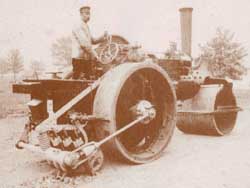
BOMFORD is this year celebrating its 100th birthday, during which time it has grown to become one of Britain's leading manufacturers of agricultural equipment with distribution throughout the World.
Like many agricultural machinery manufacturers, Worcestershire farmer Benjamin Bomford started manufacturing agricultural machinery to meet the needs of his own contracting and farming needs, prior to establishing a company in February 1904 that subsequently would manufacture machinery as diverse as steam engines, tractors, road rollers and dredging equipment.
In the late 1800's, the advent of steam power brought about a revolution in farming, one which the Bomford family was quick to embrace, buying their first steam ploughing outfit in 1864 and operating five sets by 1880.
By the early 1890's brothers Raymond and Benjamin Bomford had diversified into contracting, steam road rolling and lake clearance work, using their own design of scoop and in 1893 were joined by an engineer Harry Evershed, who had been working for the steam engine manufacturer Fowler.
Under the banner of Bomford & Evershed, in addition to dredging scoops they also started manufacturing a scarifier that went on the back of a steam roller to break up the road surface, which was exhibited at the Royal Show in Birmingham in 1898.
The engineering company Bomford & Evershed was formalised as a division of Bomford Bros on 19th February 1904 and exhibited that year at the Royal Show at Park Royal. By 1908 the company had bought the contracting side of the Bomford Brothers business and in 1909 moved to its current site at Salford Priors.
For most of the first half of the 20th Century, Bomford Bros and Bomford & Evershed operated in parallel, both manufacturing agricultural and other machinery and both involved in contracting.
In the 1920's, under Raymond's son Douglas, Bomford Bros started developing small tractors and crawlers, powered by Morris Cowley engines, and after the 2nd World War continued to develop machinery such as vegetable planters and transplanters, tree pushers and tile drainers. Meanwhile Bomford & Evershed continued to develop land clearance and ditching machinery, in addition to steam rollers.
/…
-2-
Douglas Bomford was one of the leading agricultural engineers of his time and responsible for a considerable growth in the Bomford business. After the war, he formed a partnership with his friends FW McConnell and AJ Hosier to look at and develop new ideas, and ultimately formed a business - McConnell Bomford – to pool ideas, develop prototypes and find manufacturers, such as a reversible plough of which 1400 were subsequently sold between 1959 and 1967.
The exception to this was hedgecutters, with both McConnell and Bomford developing their own machines. The early Bomford Bros machine was a balance beam type of machines, with 4,500 sold between 1949 and 1961. By 1955 Bomford had started to use PTO power and gradually started to use hydraulic power to drive a flail head.
Bomford & Evershed after the war carried on where they left off, manufacturing rollers and land clearance and drainage machinery. In 1956 the Sapper ditcher was introduced which was the first to use tractor hydraulics and development continued on earth moving blades, which had started in 1943, and graders.
In 1957, John Fox joined Bomford & Evershed, who was to spearhead a period of major growth in the company. With a background in agricultural engineering he started looking at farm machinery as an area of expansion.
By 1960, he had developed the Superflow cultivator, which overcame the structural and penetration problems of other machines on the market. Launched at the Smithfield Show in conjunction with Massey Ferguson who sold it in their colours, in 13 years 5,729 were sold, followed by the Turbotiller, of which 6,000 were sold, the Flexitine and the Dynadrive during the 1980s.
With the expansion of both companies, they were reorganised in 1966 with Bomford Bros being offered to Bomford & Evershed, and their respective contracting businesses being merged under the Bomford Bros name, so forming the start of the Bomford Group.
The contribution that Bomford & Evershed made to the development of agricultural machinery during the 1960s and early 70s was recognised by the RASE who presented the company with a Gold Medal for their Outstanding Contribution to Agriculture.
